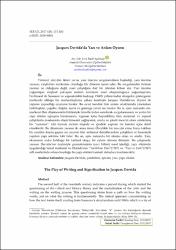Jacques Derrida’da Yazı ve Anlam Oyunu
Özet
Yirminci yüzyılın ikinci yarısı, yazı üzerine sorgulamaların başladığı, yazı üzerine yazının; eleştirinin merkezine oturduğu bir döneme işaret eder. Bu sorgulamalar özünde yazının ne olduğuna değil, nasıl çalıştığına dair bir izlekten köken alır. Yazı üzerine yoğunlaşan eleştirel yaklaşım metnin kendisini nasıl oluşturduğuna yoğunlaşırken, Ferdinand de Saussure ve yapısalcılıkla başlayıp 1960’lı yıllara kadar süregelen göstergenin merkezde olduğu bir merkezileştirme çabası kendisini Jacques Derrida’nın deyimi ile yapının yapısallığı oyununa bırakır. Bu oyun kendini tüm anlam odaklarında yinelerken farklılaştırır, çoğaltır, dağıtır, ayırır ve gösterge yerini ize bırakır. Bu iz, aynı zamanda söz- merkezci Batı düşüncesinin bütünüyle temellerinden sarsılarak sorgulanmasını ve yerini bir yapı söküm uğraşına bırakmasını, logosun içine hapsedilmiş tüm anlamsal ve yapısal çelişkilerin maskesinin düşürülmesini sağlayarak; orada ve şimdi mevcut olanı ertelenmiş bir “ayırama”1 tabi tutarak metnin dışında ve içindeki yapıları bir hareket içine dahil etmektedir. Bu dinamizm yazının iki anını imler. Öncelikle bir ters-yüz etme, bunu takiben bir yeniden kayda geçme anı yazının tüm anlamsal duraklarındaki çelişkileri ve hiyerarşik yapıları yapı söküme tabi tutar. Bu an, aynı zamanda bir okuma olayı ve anıdır. Yazı, okumanın vuku bulduğu bir tarihsel oluşa, bir eylem alanına dönüşür. Bu çalışmada, yazının Derrida’nın deyimiyle gramatolojinin (yazı bilimi) nasıl işlediği, yapı sökümün uygulandığı temel metinleri ve Derrida’nın “Yazıbilime Dair”(1967) ve “Yazı ve Fark”(1967) adlı eserlerinde ortaya koyduğu bu yapı söküm hareketi detaylıca incelenecektir. The second half of the twentieth century indicates a period during which started the questioning of the critical and literary theory and the centralisation of the critic and the writing on the writing process. This questioning stems from a path on how the writing works, not on what the writing is fundamentally. The critical approach concentrating on how the text forms itself, starting from Saussure’s structuralism until 1960s which is a try of the centralisation of the sign leaves itself to a play of the structurality of the structure. This play whereas reiterates itself in all signification focuses, diversifies, reproduces, separates and disseminates and the sign turns to be the trace. This trace leads the structures outside and inside of the text into a movement subjecting which is actually there to a differance of deferral by ensuring the unmasking of all semantic and structural contradictions confined into the “logos” by questioning the totality and rocking to its foundations the thought of Western logocentrism and by erasing on-going metaphysics of presence giving way to a deconstruction. This movement bring along not only a deconstruction but also a reconstruction. This dynamism marks the two moments of the writing. First of all a procedure of eversion and a moment of re-inscription deconstruct all semantic contradictions, illusions, structures depending on the metaphysics of presence. This moment is also a moment and an event of lecture, the writing turns to be a field of action and a historical being in which the lecture happens. In this research, the movement of the deconstruction existing in the principal texts of Derrida entitled “Of Grammatology” (1967) and “Writing and Difference” (1967) and how grammatology works will be deeply examined.
Kaynak
Selçuk Üniversitesi Edebiyat Fakültesi DergisiCilt
0Sayı
38Bağlantı
http://www.trdizin.gov.tr/publication/paper/detail/TWpreU5UZzJOZz09https://hdl.handle.net/11421/15412


















